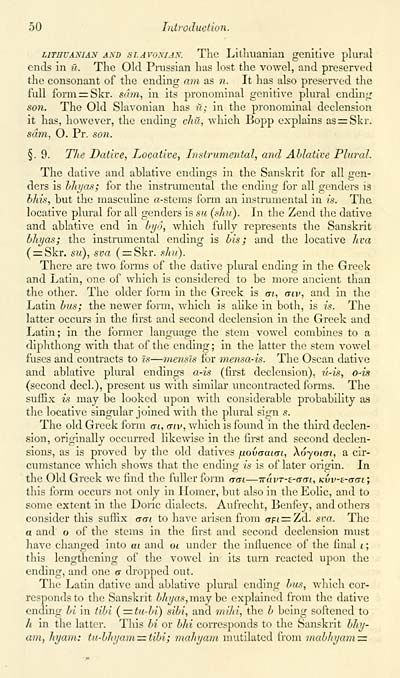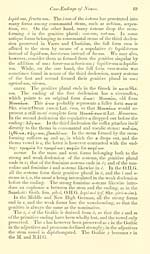Blair Collection > Celtic studies
(80)
Download files
Complete book:
Individual page:
Thumbnail gallery: Grid view | List view

50 hdroduction.
LITHUANIAN AND SLAVONIAN. Tlic Litliiianian genitive plural
ends in u. The Old Prussian has lost the vowel, and preserved
the consonant of the ending am as n. It has also preserved the
full form=:Skr. sum, in its pronominal genitive plural ending
son. The Old Slavonian has n; in the pronominal declension
it has, however, the ending chit, which Bopp explains as = Skr.
s«m, O. Pr. son.
§. 9. Tlie Dative, Locative, Instrumental, and Ablative Plural.
The dative and ablative endings in the Sanskrit for all gen-
ders is hliyas; for the instrmnental the ending for all genders is
hhis, but the masculine a-stems fonn an instrumental in is. The
locative plural for all genders is su (shu). In the Zend the dative
and ablative end in bi/o, which i'ully represents the Sanskrit
bhyas; the instrumental ending is bis; and the locative hva
(=:Skr. su), sva ( = Skr. sJni).
There are two forms of the dative plural ending in the Greek
and Latin, one of which is considered to be more ancient than
the other. The older form in the Greek is ai, aiv, and in the
Latin bus; the newer form, which is alike in both, is is. The
latter occurs in the first and second declension in the Greek and
Latin; in the former language the stem vowel combines to a
diphthong with that of the ending ; in the latter the stem vowel
fuses and contracts to L*; — mensJs for mensa-is. The Oscan dative
and ablative phu'al endings a-is (first declension), u-is, o-is
(second decL), present us with similar imcontracted forms. The
suffix is may be looked upon with considerable probability as
the locative singular joined with the plural sign s.
The old Greek form ai, aiv, which is found in the third declen-
sion, originally occurred likewise in the first and second declen-
sions, as is proved by the old datives fxovaaiai, Xoyoim, a cir-
cumstance which shows that the ending is is of later origin. In
the Old Greek we find the fuller form o-o-t — TravT-e-rrai, Kvv-e-aai;
this form occurs not only in Homer, but also in the Eolic, and to
some extent in the Doric dialects. Aufrecht, Benfey, and others
consider this suffix (rai to have arisen from (rF< = Zd. sva. The
a and o of the stems in the first and second declension must
have changed into ai and oi under the influence of the final i ;
this lengthening of the vowel in its turn reacted upon the
ending, and one a di'opped out.
The Latin dative and ablative plural ending bus, which cor-
responds to the Sanskrit bhyas,ina,yhc explained from the dative
ending In in tibi (■=tu-bi) sibi, and mihi, the b being softened to
h in the latter. This bi or bhi corresponds to the Sanskrit bhi/-
am, hi/am: tu-bJiyam=ztibi; inahyam nuitilated from )nabJiyamz=
LITHUANIAN AND SLAVONIAN. Tlic Litliiianian genitive plural
ends in u. The Old Prussian has lost the vowel, and preserved
the consonant of the ending am as n. It has also preserved the
full form=:Skr. sum, in its pronominal genitive plural ending
son. The Old Slavonian has n; in the pronominal declension
it has, however, the ending chit, which Bopp explains as = Skr.
s«m, O. Pr. son.
§. 9. Tlie Dative, Locative, Instrumental, and Ablative Plural.
The dative and ablative endings in the Sanskrit for all gen-
ders is hliyas; for the instrmnental the ending for all genders is
hhis, but the masculine a-stems fonn an instrumental in is. The
locative plural for all genders is su (shu). In the Zend the dative
and ablative end in bi/o, which i'ully represents the Sanskrit
bhyas; the instrumental ending is bis; and the locative hva
(=:Skr. su), sva ( = Skr. sJni).
There are two forms of the dative plural ending in the Greek
and Latin, one of which is considered to be more ancient than
the other. The older form in the Greek is ai, aiv, and in the
Latin bus; the newer form, which is alike in both, is is. The
latter occurs in the first and second declension in the Greek and
Latin; in the former language the stem vowel combines to a
diphthong with that of the ending ; in the latter the stem vowel
fuses and contracts to L*; — mensJs for mensa-is. The Oscan dative
and ablative phu'al endings a-is (first declension), u-is, o-is
(second decL), present us with similar imcontracted forms. The
suffix is may be looked upon with considerable probability as
the locative singular joined with the plural sign s.
The old Greek form ai, aiv, which is found in the third declen-
sion, originally occurred likewise in the first and second declen-
sions, as is proved by the old datives fxovaaiai, Xoyoim, a cir-
cumstance which shows that the ending is is of later origin. In
the Old Greek we find the fuller form o-o-t — TravT-e-rrai, Kvv-e-aai;
this form occurs not only in Homer, but also in the Eolic, and to
some extent in the Doric dialects. Aufrecht, Benfey, and others
consider this suffix (rai to have arisen from (rF< = Zd. sva. The
a and o of the stems in the first and second declension must
have changed into ai and oi under the influence of the final i ;
this lengthening of the vowel in its turn reacted upon the
ending, and one a di'opped out.
The Latin dative and ablative plural ending bus, which cor-
responds to the Sanskrit bhyas,ina,yhc explained from the dative
ending In in tibi (■=tu-bi) sibi, and mihi, the b being softened to
h in the latter. This bi or bhi corresponds to the Sanskrit bhi/-
am, hi/am: tu-bJiyam=ztibi; inahyam nuitilated from )nabJiyamz=
Set display mode to: Large image | Transcription
Images and transcriptions on this page, including medium image downloads, may be used under the Creative Commons Attribution 4.0 International Licence unless otherwise stated. ![]()
| Early Gaelic Book Collections > Blair Collection > Celtic studies > (80) |
|---|
| Permanent URL | https://digital.nls.uk/75772107 |
|---|
| Description | A selection of books from a collection of more than 500 titles, mostly on religious and literary topics. Also includes some material dealing with other Celtic languages and societies. Collection created towards the end of the 19th century by Lady Evelyn Stewart Murray. |
|---|
| Description | Selected items from five 'Special and Named Printed Collections'. Includes books in Gaelic and other Celtic languages, works about the Gaels, their languages, literature, culture and history. |
|---|

